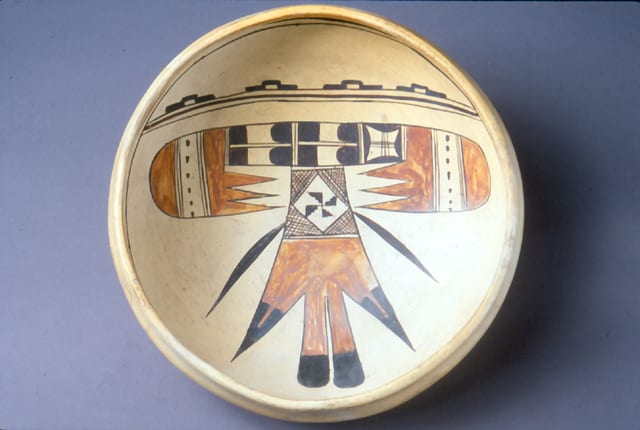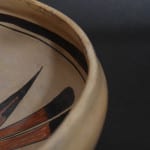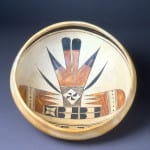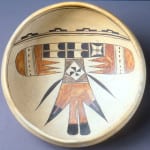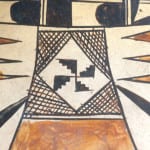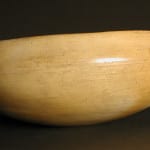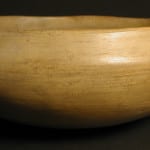Low polychrome bowl with an everted rim and a bird tail design formed and perhaps painted by “Old Lady” Nampeyo. There is a contrary informed opinion that the bowl was painted by her daughter Annie.
Note that the “3-brick” element that appears four times at the top of the design is a version of an ancient design found on shards at ancient Hopi villages and on one other bowl in this collection (1994-02):
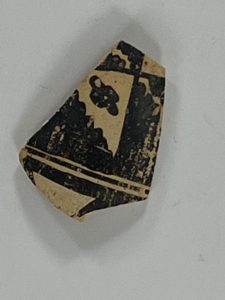
There is extensive appraisal and documentation of the pot on file, much of which depicts the pot as both formed and painted by Nampeyo:
Andrea Fisher writes: “Polychrome bowl by Nampeyo (1860-1942) from Hano village on the Hopi reservation, Arizona. C. 1900. Eleven inches in diameter by four inches high. Bird tail design. The condition is excellent.”
At Andrea’s request, Robert Ashton of Morning Star Gallery wrote an appraisal (8/21/96):
“This is a classic example of a Hano polychrome bowl made by the potter Nampeyo. The white slip is typical of Nampeyo’s work during this (1900-1910) period. The design, a stylized rainbird, is constructed in the same manner as seen on many other of her bowls. The lack of a line break and the thickness of the bowl all reflect her work during 1900-1910. In my opinion, this is an excellent example of Nampeyo’s work.”
In January 2005, Ed Wade (also a Nampeyo scholar) reviewed the website photographs of this pot and said it was “certainly” an “Old Lady” pot.
Barbara Kramer saw a picture of the pot and came to a radically different conclusion. See her letter regarding 1993-04, the Nampeyo “Bird Hanging from Sky Band” pot, on file:
“And here I will throw you a loop, but when I first glanced at your bowl 1996-05 I intuitively felt “Annie.” And I still do. Why? Annie used the swastika in designs. The design has a delicacy about it; the dots in the negative white strips at the ends of the wings are almost timid, and only Annie used dots in the wingtips of her migration pattern. Nampeyo wouldn’t have left the solid red body under the swastika but would have embellished it. The delicate black band above the design contains a half-pattern of the same design on your gorgeous Annie bowl (1994-02). [Design sketch removed]. I think (1996-05) is an early Annie bowl as opposed to your later ca 1912 Annie bowl with complex design (1994-02). Can you prove me to be wrong or am I blowing your day completely?”
In her book, Barbara Kramer dates Nampeyo bowls with everted rims to the period “pre-1900.” (Kramer, 1996:167 and 179.) Yet if bowl 1996-05 was painted before 1900, Annie (who was born in 1884), would have been too young to do this painting. If the bowl was made closer to 1910, Annie would have had the skills to do the painting. It is possible that Barbara Kramer is correct and Annie painted this bowl, but an older Annie would push the production of everted rim bowls after 1900, contradicting Kramer’s sequencing of vessel profiles.
Given my subsequent analysis of Nampeyo’s design technique (see Appendix B), the contradictory elements, tension and energy that often characterizes Nampeyo’s Sikyatki Revival painting are absent from 1996-05. I believe that this lack of stylistic tension results in the “delicacy” that Kramer noticed. Given that Barbara Kramer has studied Nampeyo and Annie pots more systematically and carefully than most authorities, and the delicacy and lack of tension in the design, I can understand her assessment that Annie was the painter of this pot.
Robert Ashton, Barbara Kramer and Ed Wade are all recognized Nampeyo authorities. . Since Kramer is the more objective scholar and Ashton a dealer writing an appraisal for a dealer friend, Kramer’s may be the more objective opinion. However, the consensus does not support Kramer’s attribution of the painting to Annie.
Given this divergence of informed opinion, I am unsure if this bowl was painted by Nampeyo or Annie. If forced to decide, the lack of stylistic tension in the design would incline me to agree with Barbara Kramer’s assessment, but other authorities may well be correct. Not all Nampeyo bowls fit the stylistic criteria I define as characteristic of Nampeyo’s Sikyatki Revival bowls. Certainly her design temperament was more variable that my later definition of her style. As Kramer writes in her book, most of Annie’s work was sold with her Mother’s and not identified as Annie’s (1996:179).. Who knows? In any case, this pot is a good example of that early confusion (and a Hopi sense that the identity of the maker is of little importance). For other unsigned pots formed by Nampeyo and probably painted by a daughter, see the Category List.
Andrea Fisher obtained this pot from Marshall M. Miller of Orchard Lake, Michigan. In a July 30, 1996 letter to Andrea, he detailed the history of the pot:
Andrea, I’m going to tell you all I know about the bowl that you asked about. This bowl came out of the Mulberger collection and was a published piece. I wished I had a catalog to send you but I don’t. I have researched the bowl and the catalog both to no avail. Carl (Mulberger?) had this small catalog printed – paid cash for everything – and never gave the printer his address. At any rate this bowl first turned up in the Peter Ray collection. He was married to I believe Martha Firestone of (Firestone Tire Co.) when she found out that Peter was playing with other ladies. She got rid of him but most of the pottery was gone at any price (?) and no one could find out about it. I understand that Peter loved the bottle (not a measuring bottle) at any one time the Firestone Ray family was believed to have 200 ceramics prehistoric and historic. Where they went nobody knows – this is going back many years.
It’s difficult to determine whether this bowl is Sikyatki or if it was done by Nampeyo –there is no history on it. I did not purchase it as Sikyatki and it could well be Sikyatki unless I had positive proof, I could not say it was a Sikyatki. There were two villages that were making Sikyatki going back to about 1500 the Zuni influence. I don’t think it is Sikyatki and if it were how would anyone know unless it was documented. I showed the bowl to Dextra and she felt that her Grandmother could have made that bowl in her later years in life. She called Dextra , Deshed – because she could not say Dextra. Dextra went on to say this was an old Zuni design (and) as you know the Zuni’s had a great effect on the Hopi culture where ceramics were concerned. She also pointed out the layout of painting on the inside was certainly consistent with work of Nampeyo. I can tell you that whoever made it was a skilled craftsperson – it’s too bad that Fewkes or Keam did not make a drawing of the bowl and then there would be no doubt. Under normal times I would keep it – but we have had it a long time and someone else should enjoy it. It’s a treasure to own. Now you know what I know.
—Marshall
Marshall Miller is correct: Whoever made this bowl made a visual treasure.

